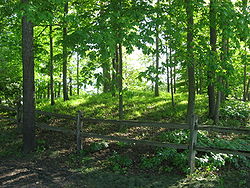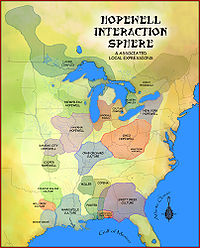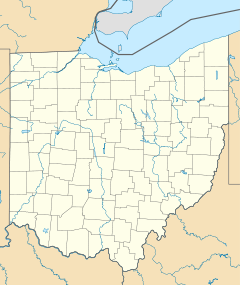- Dunns Pond Mound
-
Dunns Pond Mound
 Northeastern side of the mound
Northeastern side of the moundLocation: Junction of Mohawk and Mound Aves., northeast of Dunns Pond[2] Nearest city: Huntsville, Ohio Coordinates: 40°28′32.44″N 83°51′46.4″W / 40.4756778°N 83.862889°WCoordinates: 40°28′32.44″N 83°51′46.4″W / 40.4756778°N 83.862889°W Area: 1 acre (0.40 ha) Governing body: Private NRHP Reference#: 74001548[1] Added to NRHP: July 30, 1974 The Dunns Pond Mound is a historic Native American mound in northeastern Logan County, Ohio, United States. Located near Huntsville,[1] it lies along the southeastern corner of Indian Lake in Washington Township.[2] In 1974, the mound was listed on the National Register of Historic Places as a potential archeological site,[1] with much of its significance deriving from its use as a burial site for as much as nine centuries.[2]
Other Native American earthworks are located in the vicinity. A 1914 study found fifteen mounds on the southeastern side of Indian Lake and characterized this "remarkable" group of mounds as the premier location of archeology in Logan County.[3] Another four mounds in Washington Township, which were not included in the 1914 survey, are located on Lake Ridge Island,[4] a short distance to the north of Dunns Pond.[5] These mounds, the Lake Ridge Island Mounds, were listed on the Register on the same day as was the Dunns Pond Mound.[1]
Contents
History
It is believed that the Dunns Pond Mound was built by the prehistoric Hopewell peoples at some point between 300 BC and AD 600. While approximately twenty mounds have been recorded around southeastern Indian Lake in modern times, it is likely that many more once existed in the area.[2] When the Miami River was dammed in 1860 to support canal traffic, Indian Lake became far larger than its natural boundaries.[6] Farmland became lake bottom and small hills became islands;[4] the mound suddenly lay near the shoreline,[2] and a small bay of the lake immediately south of the mound was later named Dunns Pond. Consequently, if villages or mounds existed northwest of the Dunns Pond Mound, they have been submerged.[5]
Long after the expansion of Indian Lake, the Dunns Pond Mound was little known. For many decades, it was surrounded by woodlands, and the only human activity in the vicinity occurred along a bicycle and snowmobile path that passed over the mound. Excavation was attempted in the early 1940s, but was soon stopped without yielding any significant finds. However, the mound continued to receive attention from archeologists, and in 1974 it was listed on the National Register because it was likely to yield information about the peoples of the past. While the mound was likely built as a charnel house for Hopewell death rites, later Late Woodland peoples also used the mound as a burial site.[2]
Interest in the mound by non-archeologists has increased in recent decades. In the first half of the twentieth century, local Boy Scouts proposed clearing the mound of brush as part of a conservation project, although objection by the owner prevented this project from being carried out. Increasing development around Indian Lake has included the creation of a small community around Dunns Pond, named Moundwood;[5] the mound is located on the edge of the community.[2] Access to the mound itself is no longer easily possible; the trail has been removed, and a fence placed around the mound.[7]
See also
- List of burial mounds in the United States
References
- ^ a b c d "National Register Information System". National Register of Historic Places. National Park Service. 2009-03-13. http://nrhp.focus.nps.gov/natreg/docs/All_Data.html.
- ^ a b c d e f g Drennen, Bert C., III. National Register of Historic Places Inventory/Nomination: Dunns Pond Mound. National Park Service, 1974-01-22.
- ^ Mills, William C. Archeological Atlas of Ohio. Columbus: Ohio State Archeological and Historical Society, 1914, page 46 and plate 46.
- ^ a b Drennen, Bert C., III. National Register of Historic Places Inventory/Nomination: Lake Ridge Island Mounds. National Park Service, 1974-01-22.
- ^ a b c Detailed map of Indian Lake, Logan County Engineer's Office. Accessed 2009-07-16.
- ^ Indian Lake State Park, Ohio Department of Natural Resources, 2009. Accessed 2009-07-16.
- ^ View of site provided by this picture
Further reading
- Koleszar, Stephen C. An Archaeological Survey of Southwestern Ohio. Columbus: Ohio Historical Society, 1970.
 Hopewellian peoplesWoodland period · List of Hopewell sites · Mound builder (people) · List of archaeological periods (North America)
Hopewellian peoplesWoodland period · List of Hopewell sites · Mound builder (people) · List of archaeological periods (North America)Ohio Hopewell Beam Farm · Benham Mound · Cary Village Site · Cedar-Bank Works · Dunns Pond Mound · Ellis Mounds · Ety Enclosure · Ety Habitation Site · Fort Ancient · Fortified Hill Works · Great Hopewell Road · High Banks Works · Hopeton Earthworks · Hopewell Culture National Historical Park · Indian Mound Cemetery · Keiter Mound · Marietta Earthworks · Moorehead Circle · Mound of Pipes · Nettle Lake Mound Group · Newark Earthworks · Oak Mounds · Perin Village Site · Portsmouth Earthworks · Seip Earthworks and Dill Mounds District · Shawnee Lookout · Tremper Mound and Works · Williamson Mound Archeological District
Crab Orchard culture Goodall Focus Goodall Site · Norton Mound GroupHavana Hopewell culture Kansas City Hopewell Marksville culture Miller culture Point Peninsula Complex Swift Creek culture Etowah Indian Mounds · Leake Mounds · Kolomoki Mounds Historic Park · Miner's Creek site, · Nacoochee Mound · Swift Creek mound site · Yearwood siteOther Hopewellian peoples Armstrong culture · Copena culture · Fourche Maline culture · Laurel Complex · Saugeen Complex · Old Stone Fort (Tennessee)Exotic trade items Related topics · Ancient Monuments of the Mississippi Valley · Black drink · burial mound · Calumet (pipe) · Effigy mound · Hopewell pottery · Horned Serpent · Eastern Agricultural Complex · Underwater pantherNational Register of Historic Places in Logan County, Ohio Historic district Lake Ridge Island Mounds

Other properties Dunns Pond Mound | First Concrete Street in U.S. | William Lawrence House | Logan County Courthouse | Martin Marmon House | McColly Covered Bridge | Abram S. Piatt House and Donn S. Piatt House | Schine's Holland Theatre
U.S. National Register of Historic Places Topics Lists by states Alabama • Alaska • Arizona • Arkansas • California • Colorado • Connecticut • Delaware • Florida • Georgia • Hawaii • Idaho • Illinois • Indiana • Iowa • Kansas • Kentucky • Louisiana • Maine • Maryland • Massachusetts • Michigan • Minnesota • Mississippi • Missouri • Montana • Nebraska • Nevada • New Hampshire • New Jersey • New Mexico • New York • North Carolina • North Dakota • Ohio • Oklahoma • Oregon • Pennsylvania • Rhode Island • South Carolina • South Dakota • Tennessee • Texas • Utah • Vermont • Virginia • Washington • West Virginia • Wisconsin • WyomingLists by territories Lists by associated states Other Categories:- Ohio Hopewell
- Archaeological sites on the National Register of Historic Places in Ohio
- Geography of Logan County, Ohio
Wikimedia Foundation. 2010.


